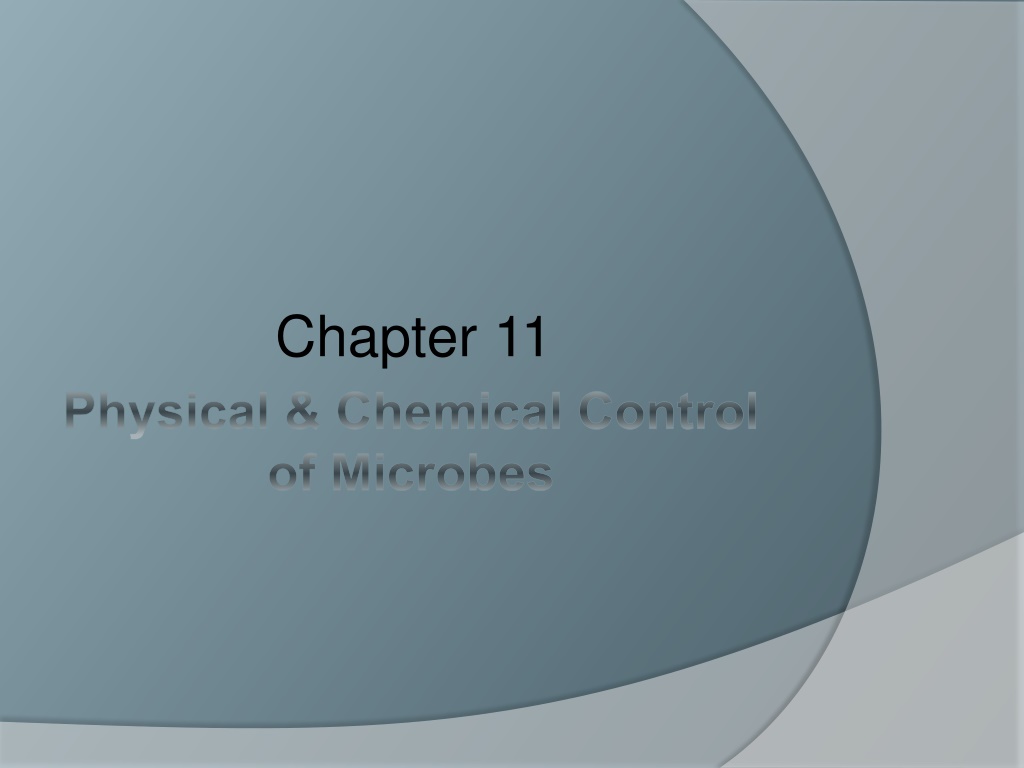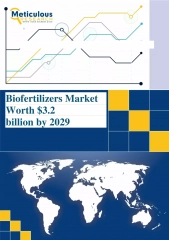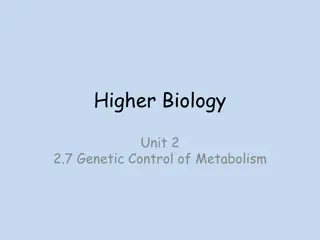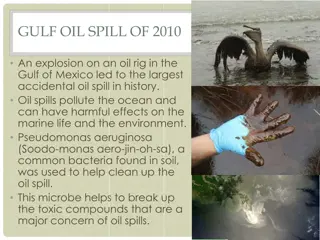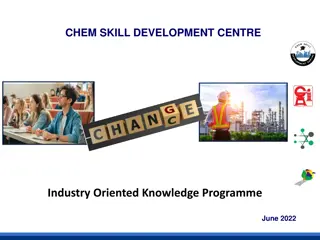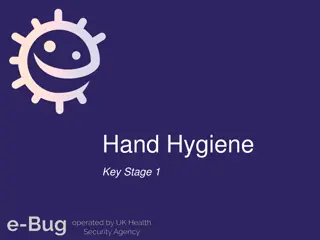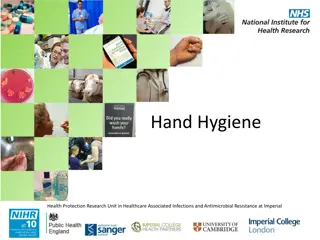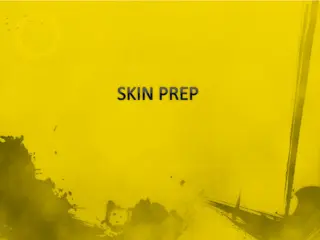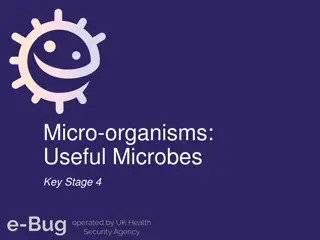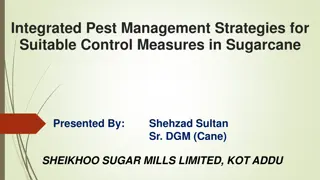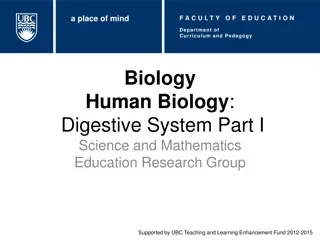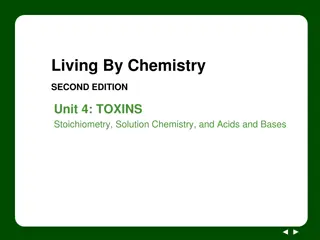Physical and Chemical Control of Microbes
This chapter explores the methods of controlling microorganisms through sterilization, disinfection, antisepsis, and sanitization. It discusses the desired level of cleanliness, resistance of microbial forms, and various techniques used to eliminate or inhibit different types of microorganisms.
Download Presentation

Please find below an Image/Link to download the presentation.
The content on the website is provided AS IS for your information and personal use only. It may not be sold, licensed, or shared on other websites without obtaining consent from the author. Download presentation by click this link. If you encounter any issues during the download, it is possible that the publisher has removed the file from their server.
E N D
Presentation Transcript
Chapter 11 Physical & Chemical Control of Microbes
11.1 Controlling Microorganisms A. General Considerations in Microbial Control 1. Desired level of cleanliness A) Some methods kill all organisms while others allow varying levels of microbial survival B) Multiple factors will determine which methods can be used
Controlling Microorganisms 2. Relative Resistance of Microbial Forms A) Primary targets of microbial control are the microorganisms that can cause infection or spoilage that are constantly present in the external environment B) These microorganisms show varying resistance to forms of control 1) Highest resistance prions & bacterial endospores
Controlling Microorganisms 2) Moderate resistance protozoan cysts, some fungal spores, naked viruses, and some hearty bacteria (M. tuberculosis, S. aureus and Pseudomonas sp.) 3) Lowest resistance most vegetative bacterial cells, most fungal spores & hyphae, enveloped viruses, yeasts, and protozoan trophozoites
Controlling Microorganisms B. Methods of microbial control 1. Sterilization A) Removes all viable microorganisms including viruses & spores B) Usually reserved for inanimate objects C) Mostly performed with heat but chemicals can also be used
Controlling Microorganisms 2. Disinfection A) The use of a physical process or chemical agent (disinfectant) to destroy vegetative pathogens and most viruses B) Does not destroy bacterial endospores & some viruses C) Also removes toxins D) Usually used only on inanimate objects
Controlling Microorganisms 3. Antisepsis A) Antiseptics applied directly to exposed body surfaces to destroy or inhibit vegetative pathogens
Controlling Microorganisms 4. Sanitization A) Any cleansing technique that mechanically removes microorganisms to reduce contamination to safe levels B) Examples include washing dishes or clothes
Controlling Microorganisms 5. Degermation A) Reduces the numbers of microbes on the human skin B) Works by removing oils and microbes on the outer layer of the skin through physical or chemical means or both 1) Hand washing & surgical scrubbing 2) Swabbing with an alcohol wipe
Controlling Microorganisms C. Agents of microbial control 1. cide: to kill (doesn t necessarily result in sterilization) A) Bactericide chemical that destroys bacteria (not endospores) B) Fungicide a chemical that can kill fungal spores, hyphae, and yeasts
Controlling Microorganisms C) Virucide a chemical that inactivates viruses D) Sporicide can destroy bacterial endospores E) Germicide and microbicide chemical agents that kill a variety of microorganisms
Controlling Microorganisms 2. Stasis and static: to stand still A) Bacteristatic prevent the growth of bacteria B) Fungistatic inhibit fungal growth C) Microbistatic materials used to control microorganisms in the body (ex. antiseptics)
Controlling Microorganisms D. What is Microbial Death? 1. When various cell structures become dysfunctional and the entire cell sustains irreversible damage, OR... 2. If a cell can no longer reproduce under ideal environmental conditions
Antimicrobial Agents 3. Factors that Influence the Action of Antimicrobial Agents A) The number of microorganisms B) The nature of the microorganisms in the population C) The temperature and pH of the environment D) The concentration of the agent
Antimicrobial Agents E) The mode of action of the agent F) The presence of solvents, interfering organic matter, and inhibitors
Antimicrobial Agents E. How Antimicrobial Agents Work: Their Modes of Action 1. Affect the cell wall A) Block its synthesis, digest it, or break down its surface B) The cell becomes fragile and is lysed easily C) Ex. penicillin, cephalosporins, vancomycin, detergents, and alcohol
Antimicrobial Agents 2. Affect the cell membrane A) Disrupt the normal transport of materials in/out of the cell or allow the free flow of substances in/out of the cell B) Ex. surfactants detergents that essentially open holes in the membrane
Antimicrobial Agents 3. Affect protein synthesis A) Disruption of DNA transcription or replication 1) Ex. ciprofloxacin, sulfonamides, and radiation (gamma, UV and X) B) Disruption of translation in the ribosomes 1. Ex. streptomycin, tetracycline, chloramphenicol, and erythromycin
Antimicrobial Agents 4. Affect protein function A) Generally work by altering the protein s natural structure (conformation) 1) Denaturation involves the breaking of bonds within the protein to disrupt its conformation 2) Coagulation aggregation of proteins resulting in a non-functioning mass
Physical Control 11.2 Methods of Physical Control A. Heat as an Agent of Microbial Control 1. Generally, elevated temperatures are microbicidal and lower temperatures are microbistatic 2. Common Methods of Moist Heat Control
Physical Control A) Steam under pressure (steam sterilization) 1) Steam can only reach 100 degrees under normal pressure; increasing the pressure allows for higher temps and better microbe killing 2) Destroys vegetative cells, spores, and viruses
Physical Control 3) Autoclave the commercial device used for steam-heat sterilization a) Similar in function to a pressure cooker b) Average settings are 15psi, 121 degrees, 15 minutes
Physical Control 4) Effective at sterilizing heat-resistant materials (glassware, cloth, metallic instruments, liquids, etc) and any material that will be discarded (plastic Petri dishes and pipets) 5) Not effective in sterilizing substances that repel or absorb moisture (waxes, oils, powders)
Physical Control B) Non-pressurized Steam 1) Sometimes referred to as intermittent sterilization 2) Expose to free-flowing steam for 30- 60 minutes, incubate for 23-24 hours, treat again; repeat for 3 days in a row 3) Destroys vegetative cells and viruses but not spores
Physical Control 4) Most often used to sterilize heat- sensitive culture media a) These allow spores to germinate in- between rounds 5) Not effective at sterilizing objects that don t allow for microbial growth but can disinfect them
Physical Control C) Pasteurization (hot water) 1) Technique in which heat is applied to liquids to kill potential agents of infection and spoilage while maintaining the flavor and food value 2) Does not sterilize the liquid as spores, thermoduric and thermophilic orgs still remain
Physical Control 3) 3 methods a) Flash pasteurization 71.6 C for 15 sec i) Common is Europe & Asia b) Batch pasteurization 63-66 C for 30 min i) Traditional method used in U.S. c) Ultrahigh-temperature (UHT) pasteurization 134 C for 1-2 sec
Physical Control i) Allows milk to be stored for long periods at room temp (ex. coffee creamers) 4) Goal is to prevent the transmission of milk-borne diseases from infected cows and milk handlers 5) Does not kill all microbes
Physical Control D) Boiling Water 1) For disinfection and not sterilization 2) Expose materials to boiling water for 30 minutes a) 10 minutes will kill all non-spore- forming pathogens & most viruses
Physical Control 3) Used by many to decontaminate suspect drinking water 4) Recontamination after removal from water is the biggest downside with disinfection objects with this method
Physical Control 3. Dry Heat incineration and hot air A) Incineration 1) Ignites and reduces microbes to ashes and gas 2) Common practice in microbiology lab flaming the loop 3) Hospitals often use incineration to eliminate their infectious waste materials
Physical Control B) Dry Oven (hot air) 1) Electric coils radiate heat within an enclosed compartment 2) Sterilization occurs at 150-180 C for 2-4 hours 3) Used for heat-resistant items that do not sterilize well with moist heat (some glassware, powders, oils, and metallic instruments)
Physical Control B. The Effects of Cold and Desiccation 1. Cold Treatment refrigeration & freezing A) Designed to slow microbial growth B) Common in food processing and storage C) Not considered a viable method of sterilization or disinfection
Physical Control 2. Desiccation drying A) Inhibits growth by removing water B) Inhibits the spread of most pathogens but not all of them C) Lyophilization mixture of freezing & drying 1) Used to preserve microbes and other cells for long periods of time D) Not considered a viable method of sterilization or disinfection
Physical Control C. Radiation as a Microbial Control Agent 1. Radiation energy emitted from atomic activities and dispersed at high velocity through matter or space 2. 2 categories of radiation A) Ionizing radiation 1) Excites the electrons to the point that they are ejected from the molecule entirely causing the formation of ions
Physical Control a) DNA is most sensitive 2) Also causes lethal chemical changes in organelles and the production of toxins 3) Used in the sterilization of commercial food products a) Potential problems include changing flavor and nutritional value, and introducing undesirable chemical reactions
Physical Control 4) Is the preferred methods for sterilizing drugs and tissues by hospitals 5) Potential danger to machine operators and possible damage to some materials are its disadvantages 6) Examples include gamma rays, X rays, and cathode rays
Physical Control B) Non-ionizing radiation 1) Excites electrons causing them to jump orbitals but don t leave the molecule a) Leads to abnormal linkages and bonds within molecules b) DNA again is very susceptible i) Thymine dimers are a common result
Physical Control 2) UV rays are the primary example a) Excellent for disinfecting air i) Commonly seen in lights found in hospital rooms, operating rooms, schools, food prep areas, and dental offices ii) Sometimes used to treat drinking water or purify liquids
Physical Control b) Does not pass easily through solids but is used in some applications c) Poses threat to human tissue if overexposure occurs
Physical Control D. Decontamination by Filtration 1. Effective for removing microbes from air and liquids 2. Fluid strained through a filter with openings large enough for fluid but too small for microorganisms
Physical Control 3. Pore size can be controlled and standardized A) Can be small enough to trap viruses 4. Applications of Filtration A) Prepare liquids that can t withstand heat 1) Serum and other blood products, vaccines, IV fluids, and enzymes
Physical Control B) Can decontaminate beverages without altering their flavor C) Water purification D) Removing airborne contaminants (HEPA filters)
Physical Control E. Other methods of Physical control 1. Sound Waves A) Used high-frequency sound waves to disrupt cell structure B) Sonicator water-filled chamber through which the sound waves become vibrations that can disrupt cell structure
Physical Control C) Gram-negative bacteria are most susceptible D) Often used to clean debris from instruments before sterilization E) Not a reliable form of disinfection or sterilization
Physical Control 2. Osmotic Pressure (salt concentration) A) Involves the use of salt to create a hypertonic environment B) Results in water leaving the cell, inhibiting cellular processes
Chemical Agents 11.3 Chemical Agents in Microbial Control A. Germicidal Categories According to Chemical Group 1. Halogens A) Fluorine, bromine, chlorine, and iodine B) They generally disrupt microbial enzyme function
Chemical Agents C) Effective against vegetative cells and some spores D) Ex. household bleach (chlorine) & Betadine (iodine) 2. Phenol and its Derivatives A) Effective against vegetative cells but not spores
Chemical Agents B) They denature proteins and disrupt cell membranes C) Often have a nasty odor and some side effects D) Ex. orthophenylphenol (active ingredient in Lysol), hexylresorcinol (used in some throat lozenges), and hexochlorophene (Phisoderm)
Chemical Agents 3. Alcohols A) Effective against vegetative cells but not spores 1) More effective in inactivating enveloped viruses than nonenveloped viruses B) Isopropanol and ethanol are most commonly used in 70-95% mixtures
